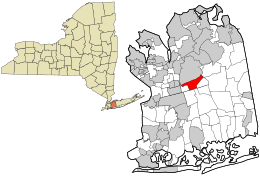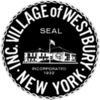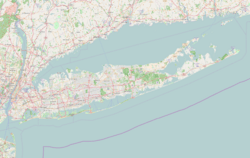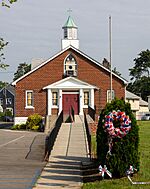Westbury, New York facts for kids
Quick facts for kids
Westbury, New York
|
||
|---|---|---|
| Incorporated Village of Westbury | ||

Westbury Village Hall on June 9, 2021.
|
||
|
||
| Motto(s):
"Community for All Seasons"
|
||

Location in Nassau County and the state of New York.
|
||
| Country | ||
| State | ||
| County | Nassau County | |
| Town | North Hempstead | |
| Incorporated | 1932 | |
| Named for | Westbury, Wiltshire, England | |
| Area | ||
| • Total | 2.34 sq mi (6.07 km2) | |
| • Land | 2.34 sq mi (6.07 km2) | |
| • Water | 0.00 sq mi (0.00 km2) | |
| Elevation | 102 ft (31 m) | |
| Population
(2020)
|
||
| • Total | 15,864 | |
| • Density | 6,767.92/sq mi (2,613.59/km2) | |
| Time zone | UTC-5 (Eastern (EST)) | |
| • Summer (DST) | UTC-4 (EDT) | |
| ZIP codes |
11590
|
|
| Area code(s) | 516 | |
| FIPS code | 36-79444 | |
| GNIS feature ID | 0970896 | |
The Incorporated Village of Westbury is a small village in Nassau County, New York. It is located on the North Shore of Long Island, about 18 miles (29 km) east of Manhattan. In 2020, about 15,864 people lived here. Westbury is known as "A Community for All Seasons" because it welcomes people from many different backgrounds.
Contents
History of Westbury Village
Early Settlers and Quaker Influence
The first people to settle in this area arrived in 1658. Many of these early settlers were Quakers, a religious group known for their peaceful beliefs. In 1657, Captain John Seaman bought a large area of land, about 12,000 acres (49 km2), from the Massapequa Indians.
A year later, Richard Stites and his family built their home here. Soon after, an English Quaker named Edmond Titus and his son Samuel joined them. In 1675, another English Quaker, Henry Willis, named the area "Westbury" after his hometown in England. Other Quaker families also moved to Westbury to freely practice their religion. The first Quaker meeting house was built in 1700.
The Jericho Turnpike and Its Past
Jericho Turnpike is a major road in Westbury today. Long ago, it was a trail used by the Massapequa Indians. In the 1600s, it separated the early farms to the north from the open Hempstead Plains to the south. Now, it's an important state highway.
Freedom and New Communities
Like many landowners in the past, some early settlers in Westbury owned slaves. However, in 1775, the Quakers decided to free all 154 African-Americans they owned. Many of these freed individuals built their own homes and farms nearby.
In 1834, with help from the Quakers, they built the New Light Baptist Church. This church later became the Westbury A.M.E. Zion Church in 1892. The church building still stands today and celebrated its 180th anniversary in 2014.
The American Revolution and New Arrivals
The American Revolution (1775-1783) brought changes to Westbury. British soldiers and German soldiers, called Hessians, lived in local homes. They took livestock and cut down trees for firewood. After the war, many Hessians chose to stay in Westbury instead of returning home. They settled in an area now called New Cassel, named after a part of Hesse where most of them came from.
Growth and Development
In 1837, the Long Island Rail Road built tracks through Westbury, making travel and trade easier. The first public school opened in 1840. The railroad also helped Italian and Irish immigrants come to Westbury to work on farms. In 1857, St. Brigid's Parish was founded for these new residents.
After the American Civil War, more African-American families came to Westbury. Some were part of the Underground Railroad, a secret network that helped slaves escape to freedom. Many stayed in Westbury, often hidden in Quaker homes. For a while, many of the small stores around the train station were owned by Black families.
From Farms to Estates
In the late 1800s, Westbury began to change. Wealthy families started buying land and building large mansions. This area is now known as Old Westbury. Post Avenue became a busy center for shops and services. Roads were built, and in 1902, Post Avenue got electricity. A water company was started in 1914.
The population of Westbury grew, and more people from Irish and Italian backgrounds moved in. In the early 1900s, New Cassel also began to develop.
A Famous Flight and World War II
A very famous event happened near Westbury in 1927. Charles Lindbergh took off from Roosevelt Field, just south of downtown, for his historic flight to Paris.
In 1932, Westbury officially became an "incorporated village." This meant it could govern itself. The village included the area called Grantsville but did not include New Cassel.
During World War II, Westbury showed great support for the country. About 1,400 people from the community, which was 20% of its population, served in the war. This was one of the highest percentages for any community in the United States.
Modern Westbury
By the mid-1950s, Westbury had very little undeveloped land left. The building boom slowed down. The population grew from 4,525 in 1940 to 14,757 by 1960. Many families from the Caribbean and Latin America began to settle in Westbury during this time and in the years that followed.
As time went on, Westbury became more like a city. It continued to welcome people from diverse backgrounds, living up to its motto, "A Community for All Seasons."
Geography of Westbury
Westbury Village covers about 2.3 square miles (6.0 km2) of land. It is entirely land, with no water areas.
Some areas around Westbury also use the "Westbury" name, even though they are not officially part of the village. These include New Cassel, Salisbury (also called South Westbury), and parts of Jericho. For example, the Westbury Music Fair (now called the NYCB Theatre at Westbury) is in the Jericho area, but it uses the Westbury postal code.
The larger area that includes Westbury Village and its neighbors is sometimes called "Greater Westbury." This area shares common interests and organizations. The main school district for this region is the Westbury Union Free School District.
Population and People
| Historical population | |||
|---|---|---|---|
| Census | Pop. | %± | |
| 1940 | 4,524 | — | |
| 1950 | 7,112 | 57.2% | |
| 1960 | 14,757 | 107.5% | |
| 1970 | 15,362 | 4.1% | |
| 1980 | 13,871 | −9.7% | |
| 1990 | 13,060 | −5.8% | |
| 2000 | 14,263 | 9.2% | |
| 2010 | 15,146 | 6.2% | |
| 2020 | 15,864 | 4.7% | |
| 2021 (est.) | 15,809 | 4.4% | |
| U.S. Decennial Census | |||
In 2010, there were 15,146 people living in Westbury. The village has a mix of different groups. About 66% of the people were White, and 20% were Hispanic White or Latino. About 12% were African American, and 2% were Asian.
Westbury is home to people from many different backgrounds. This includes European Americans (especially those with Italian roots), Black Americans, and Hispanic Americans. Many Hispanic residents come from countries like El Salvador, Honduras, and Mexico. There are also many people from the Caribbean, such as Haitians, Guyanese, and Jamaicans.
The village's nickname, "A Community for All Seasons," was chosen in the 1960s. It means that Westbury is a welcoming place for everyone, no matter where they come from.
Education in Westbury
Most of Westbury is served by the Westbury Union Free School District. This district provides education for students living in the village. A small western part of the village is served by the Carle Place Union Free School District.
Transportation in Westbury
Westbury has good transportation options. The Long Island Rail Road's Main Line stops at the Westbury station. From here, you can travel to Penn Station in New York City, Hicksville, and Port Jefferson.
Several bus routes operated by Nassau Inter-County Express also serve Westbury:
- n22: Travels between Jamaica and Hicksville.
- n22X: Also travels between Jamaica and Hicksville.
- n24: Connects Jamaica and Hicksville.
- n35: Runs between Westbury and Baldwin.
Westbury is also home to New York TRACON. This is an air traffic control center that helps guide planes flying into and out of major airports like JFK, Newark, and LaGuardia.
Notable People from Westbury
Many interesting people have connections to Westbury:
- Bud Anderson (born 1956), a former Major League Baseball player.
- Michael Cimino (1939–2016), an Academy Award-winning film director.
- Kevin Conroy (1955–2022), famous for being the voice of Batman in many cartoons and video games.
- Arthur Dobrin (born 1943), an author and professor.
- Doctor Dré (born 1963), a well-known TV host and radio DJ.
- Paul Hewitt (born 1963), a college basketball coach.
- Skip Jutze (born 1946), a former Major League Baseball player.
- Nancy McKeon (born 1966), an actress.
- Bill O'Reilly (born 1949), a talk show host.
- Joe Satriani (born 1956), a very talented guitarist and composer.
- Steve Serio (born 1987), a paralympic wheelchair basketball player.
- Tyson Walker (born 2000), a college basketball player.
- Spann Watson (1916–2010), one of the famous Tuskegee Airmen.
|
See also
 In Spanish: Westbury (Nueva York) para niños
In Spanish: Westbury (Nueva York) para niños







